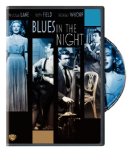| Reviews & Columns |
|
Reviews DVD TV on DVD Blu-ray 4K UHD International DVDs In Theaters Reviews by Studio Video Games Features Collector Series DVDs Easter Egg Database Interviews DVD Talk Radio Feature Articles Columns Anime Talk DVD Savant Horror DVDs The M.O.D. Squad Art House HD Talk Silent DVD
|
DVD Talk Forum |
|
|
| Resources |
|
DVD Price Search Customer Service #'s RCE Info Links |
|
Columns
|
|
|
Blues in the Night
THE MOVIE:
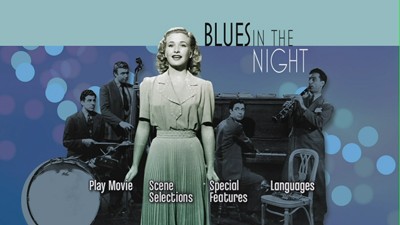
Mainstream entertainment has always had trouble adopting true underground art movements into the fold without sapping out their essential specialness, and jazz and blues are no different. Hollywood in particular has regularly stumbled when trying to make movies about any music that is remotely dangerous, whitewashing the tunes until they are palatable to the mainstream. With that in mind, Anatole Litvak's 1941 film Blues in the Night doesn't entirely escape adorning jazz with the tinsel of Tinsel Town, but it gets closer than most. Employing an expressionistic visual style that tries to match the music in terms of its improvisational abandon, Litvak manages to craft a rhythmic potboiler that may be a little too familiar when the music stops playing, but that is still undeniably entertaining.
The action opens in St. Louis, when jazz-obsessed law student and all-around mama's boy Nickie (played by future director Elia Kazan) tries for the hundredth time to convince pianist Jigger Pine (Richard Whorf) to form a band with him. Offended by the philistine tastes of a certain loudmouth member of his nightclub audience, Jigger ends up punching the guy out, and once out of a job, starts to take Nickie seriously. With Nickie on clarinet, his regular drummer Peppi (Billy Halop), and Pete the bassist (Peter Whitney), whom just happened to share their post-brawl jail cell, Jigger heads down to New Orleans. There, they recruit fast-talking trumpet player Leo (Jack Carson) and his wife, a sweet singer named Character (Priscilla Lane). With the band complete, they start riding boxcars from town to town in search of gigs.
In one of those boxcars, they meet Del Davis (Lloyd Nolan), a crook on the run who first robs the band for their measly earnings, but after they skip over ratting him out to the rail inspector, the hood takes a shine to his former victims. He's heading up to Jersey to reclaim a juke joint called the Jungle, and he offers the sextet a standing gig. Only problem is, his staff is full of shady characters, including sour-voiced siren Kay (Betty Field), a femme fatale who digs her claws into Jigger. The band breaks up, and then gets back together, and after a lurid late-night encounter, manages to snatch Jigger from the maw of darkness once more, ensuring a future of making beautiful music together.
Written by Robert Rossen (The Hustler) from a play by Kazan and Edwin Gilbert, Blues in the Night has little to offer by way of story that we haven't seen in a million music-based B-pictures. It does, however, have some amazing songs, most written by Harold Arlen and Johnny Mercer (who also wrote "Ac-Cent-Tchu-Ate the Positive" together). The title track is a classic, even if a lot of us probably know it best from its constant use in Looney Tunes. ("My mama done told me...a woman is two faced," it goes.) There are multiple "live" music numbers that really swing, and also fairly impressive big band showings, first by the Jimmie Lunceford Band in the New Orleans scene, and another theatrical number later that, despite being included as the kind of music Jigger and the gang detest, ends up being a fun production sequence. Litvak and cinematographer Ernie Haller (Rebel Without a Cause) shoot most of the musical scenes in a fashion that is rather intimate when compared to the bigger Hollywood musicals of the period. They save most of their visual tricks for the surreal montages. Edited by future action director Don Siegel, these alternately put us in the music (Rossen's hands come down onto the screen as if the viewers themselves were the piano keys) or in Jigger's crumbling psyche (he's an organ grinder's monkey, and the big band is populated entirely with replicas of Kay). Likewise, the scenery visible in the distant vistas outside the Jungle, particularly the far away skyline of New York, are lit up like a Broadway stage construction, giving the roadhouse the aura of being in a separate space from the rest of the world.
Naturally, given the date of origin, Blues in the Night has some historical inaccuracies that will be immediately apparent to audiences today. Jigger's band is entirely white, though Litvak does at least acknowledge the origins of the music, with the title track first being heard sung as a slow dirge by African American prisoners in the St. Louis jail, and the band the crew stops in to see in New Orleans is also entirely black. Given that these are two of the first three musical numbers in the picture, you have to give the filmmakers credit for trying. (Excepting, of course, the one quick shot of a black man digging into a watermelon. Ugh.) It is a little odd, though, that even though the word "blues" is in the title, it's never mentioned in the movie. Did it just not test well, and so the phrase "you've got the misery" was substituted instead? Thankfully, it's used once and then dispensed with. If Jigger had gotten the blues for real, then maybe when Kay breaks his heart, he could have tickled the ivories to deal with the pain rather than his fingers turning to mush and being unable to play. Or maybe that's what happens to white people: they get the misery, and what little rhythm they have evaporates.
Despite these antiquated anomalies, Blues in the Night remains a snappy little melodrama, a semi-noir with a cool soundtrack. For whatever its faults, one does get the sense that Anatole Litvak and his cohorts were sincere in their efforts to color the silver screen with the blues, and the result is a charming snapshot of a bunch of squares trying to act hep.
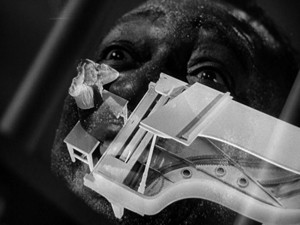
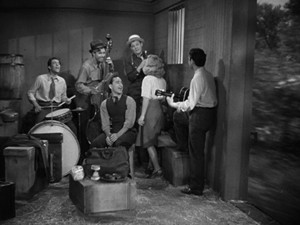
THE DVD
Video:
The fullscreen, black-and-white transfer of Blues in the Night should match pretty nicely to the film's original 1.37:1 aspect ratio. The image quality is mostly pretty good, with decent values on the various shades of gray and excellent blacks. There is occasional surface scratching that is usually accompanied by some grain in the stock, but this is not a persistent or overly egregious problem.
Sound:
A Dolby Digital monaural mix delivers a clean soundtrack that makes the music sound good without any hiss or extraneous noise.
There are subtitles in French and English Closed Captioning.
Extras:
There are multiple extras on Blues in the Night, including some that are specific to the movie, and some that are interesting nuggets excavated from the Warner Bros. library. Of the ones tied to the main feature, we get a theatrical trailer and an audio outtake of the movie's title track, a short (1 minute, 45 second) instrumental.
Two live-action musical shorts fit the subject of the movie. Melody Master: Jimmie Lunceford and his Dance Orchestra spotlights performances by the New Orleans group featured in the movie, while the Oscar-nominated 1944 short Jammin' the Blues is an artfully filmed "jam session" featuring the legendary Lester Young and his band, including vocals by Marie Bryant. (This was previously included on the disc for the Humphrey Bogart vehicle Passage to Marseille.) Both shorts are 10 minutes in length.
Three Looney Tunes animated shorts are also included. "Kitty Kornered" and "My Favorite Duck" both include interpolations of the song "Blues in the Night," and "Swooner Crooner" tangentially relates to the movie with its caricatures of famous jazz singers of the day, all of whom are portrayed as chickens.
FINAL THOUGHTS:
Recommended. Blues in the Night is not necessarily a canonized film, and probably rightly so, but Anatole Litvak's attempt to capture some jazz lightning in a bottle is an entertaining multi-reeler. The plot of a scrappy band trying to make their way in the world is pretty standard, but it's enlivened by some awesome photography and lively musical numbers. It's not necessarily the blues as they really were, but as a Hollywood attempt to do something with the style and energy of the musical movement, the movie has a few solid tricks up its sleeve.
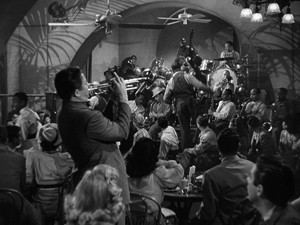
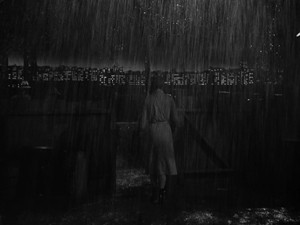
Jamie S. Rich is a novelist and comic book writer. He is best known for his collaborations with Joelle Jones, including the hardboiled crime comic book You Have Killed Me, the challenging romance 12 Reasons Why I Love Her, and the 2007 prose novel Have You Seen the Horizon Lately?, for which Jones did the cover. All three were published by Oni Press. His most recent projects include the futuristic romance A Boy and a Girl with Natalie Nourigat; Archer Coe and the Thousand Natural Shocks, a loopy crime tale drawn by Dan Christensen; and the horror miniseries Madame Frankenstein, a collaboration with Megan Levens. Follow Rich's blog at Confessions123.com.
|
| Popular Reviews |
| Sponsored Links |
|
|
| Sponsored Links |
|
|
| Release List | Reviews | Shop | Newsletter | Forum | DVD Giveaways | Blu-Ray | Advertise |
|
Copyright 2024 DVDTalk.com All Rights Reserved. Legal Info, Privacy Policy, Terms of Use,
Manage Preferences,
Your Privacy Choices | |||||||









